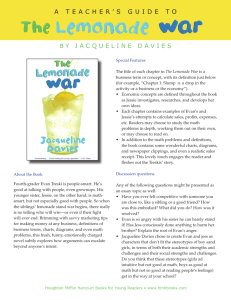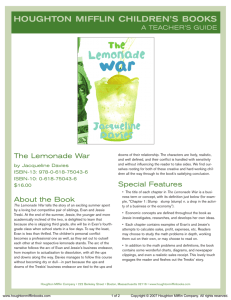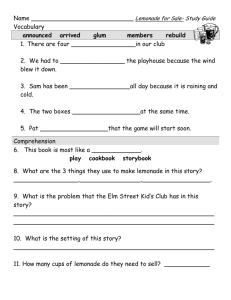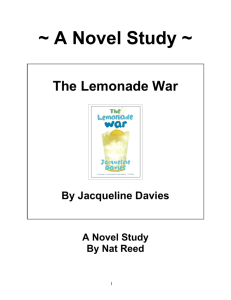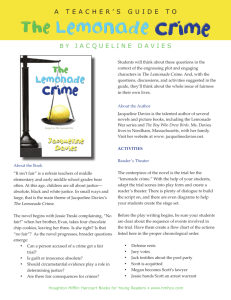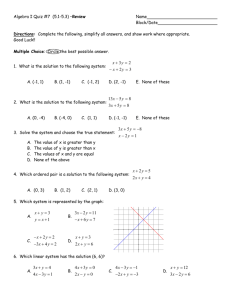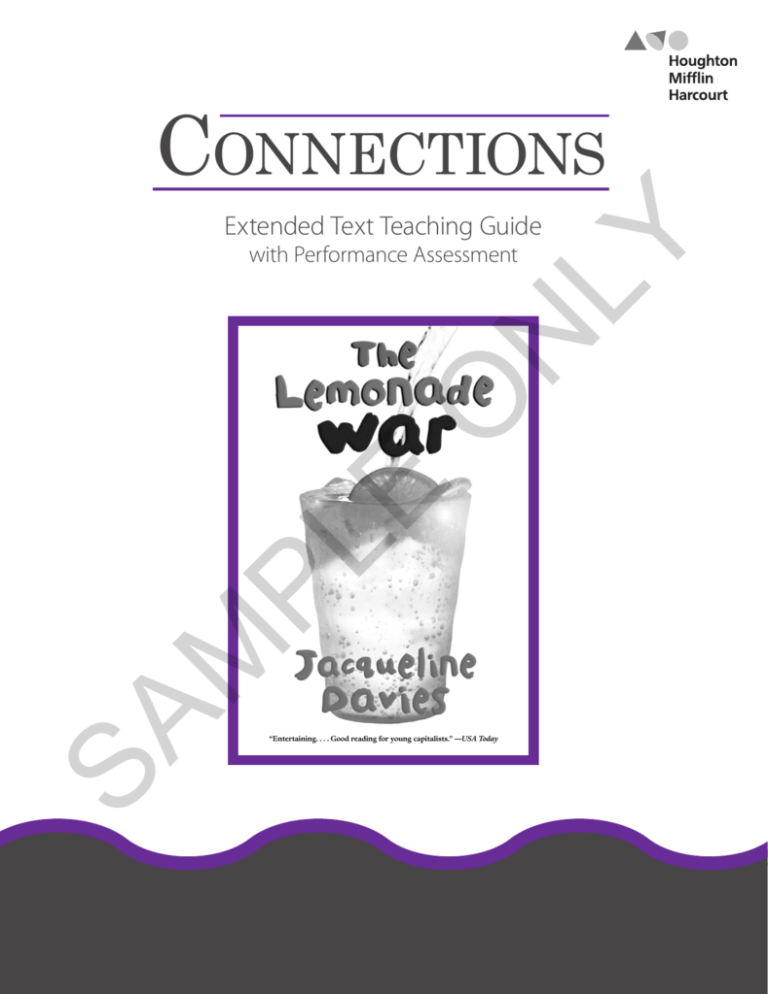
Connections
N
LY
Extended Text Teaching Guide
SA
M
PL
E
O
with Performance Assessment
The Lemonade War
by Jacqueline Davies
The new school year is a week away, and Evan Treski has been avoiding his little sister Jessie since
a letter arrived from the school stating that both siblings have been placed in the same class.
Jessie, on the other hand, is nervous about skipping third grade and thinks Evan could help ease
her transition by introducing her to the other fourth graders. Jessie enjoys her brother’s company
and can’t understand why he’s so angry. Meanwhile, Evan, who struggles academically, thinks his
overachieving sister will humiliate him. The siblings’ personal conflict plays out over a competi-
N
LY
tion to make the most money selling lemonade before Labor Day. With each chapter linked to
a business or economic principle, the pair gleans valuable lessons through the successes and
failures of their entrepreneurial ventures.
Jacqueline Davies is an award-winning children’s book author. Her idea for The Lemonade War
was inspired by an argument between her own children over who could set up a lemonade stand
in the family’s driveway. In addition to The Lemonade War series, her titles also include picture
books, fantasy, and historical fiction. Davies was born in Cleveland in 1962; today she lives in Mas-
O
sachusetts with her three children.
Page references throughout this guide are from the © 2007 hardcover and paperback edition of
PL
E
The Lemonade War. Other print and electronic versions of the text may vary.
Copyright © by Houghton Mifflin Harcourt Publishing Company
SA
M
All rights reserved. No part of this work may be reproduced or transmitted in any form or by any means,
electronic or mechanical, including photocopying or recording, or by any information storage and
retrieval system, without the prior written permission of the copyright owner unless such copying is expressly
permitted by federal copyright law. Requests for permission to make copies of any part of the work should be
addressed to Houghton Mifflin Harcourt Publishing Company, Attn: Contracts, Copyrights, and Licensing,
9400 Southpark Center Loop, Orlando, Florida 32819-8647.
Printed in the U.S.A.
ISBN 978-0-544-44448-5
1 2 3 4 5 6 7 8 9 10
4500000000
1410
23 22 21 20 19 18 17 16 15 14
ABCDEFG
If you have received these materials as examination copies free of charge, Houghton Mifflin Harcourt
Publishing Company retains title to the materials and they may not be resold. Resale of examination copies
is strictly prohibited.
Possession of this publication in print format does not entitle users to convert this publication, or any portion
of it, into electronic format.
OVERVIEW
This guide supports your teaching with The Lemonade War in an easy-to-use format.
• Plan your instruction using the teaching objectives, reading assignment, and critical vocabulary list.
• Focus students’ attention with questions that send them back to the text for discussions or writing.
• Teach and assess with ideas for comprehension support, vocabulary development, and writing practice.
• Use Text Complexity notes to help all students unpack meaning.
The main objectives of the lessons and activities in
this guide are to help students
• describe characters in a story
• describe how parts of a story build on earlier
episodes
• determine a central message of a story
WORD STUDY
N
LY
OBJECTIVES
Additionally, students will learn to
• analyze point of view
• identify and analyze conflict in a story
• analyze cause and effect
• write dialogue using correct punctuation
O
• The academic vocabulary words in the box appear in The Lemonade War. Introduce these words before students read the book.
Then display the words in the classroom and encourage students
to use them as they discuss the text.
complicated
equation
determined
emphasis
estimate (v.)
philosopher
PL
E
• Each lesson also includes a list of critical vocabulary words from
the reading assignment. You may preview these words before
students read each chapter.
ACADEMIC VOCABULARY
INTRODUCE THE TOPIC
• Tell students that they are going to read The Lemonade War. Have students preview the book’s cover.
• Display this essential question in a prominent place: How do people try to succeed? Tell students that
this question can help them focus on important events and ideas as they read.
SA
M
• Work with students to make a list of general “success tips” that might apply to any project or competition.
(Examples may relate to the importance of creativity, teamwork, and effort.) Encourage students to add to
and revise this list as they read.
PREVIEW THE PERFORMANCE ASSESSMENT
Tell students that after they finish reading and discussing the book, they will write a plan for a new business.
Suggest that, as they read, they pay attention to details that relate to planning a business.
CONNECT TO HOME
Families can share their experiences with businesses and youth-run enterprises. Readers can describe the
business concepts that each chapter introduces and discuss examples.
Connections the lemonade war 3 POINT OF VIEW
PLAN
TEACH AND ASSESS
• Describe effects of
sound devices.
Reading Assignment
Chapters 1–2
2.READ Read aloud the first two chapters. Encourage students to pay attention to how they learn about the thoughts
and feelings of the characters in each chapter.
3.WORD STUDY Tell students that authors often use words
that represent sounds to add to the meaning or feeling of
a story. Point out the words thwap, scra-a-a-ape, pop, crack,
and thud in Chapter 1. Ask: How do these words help the reader understand Evan’s feelings? (the sounds emphasize his boredom, frustration, and growing anger)
O
Critical Vocabulary
humiliated, nervousness,
attention, competition,
attract, customer
N
LY
1. COMPREHENSION Explain that a third-person narrator describes events as an outsider. Third-person narrators may tell
the thoughts and feelings of one character or all main characters. Discuss how differences in point of view can affect a story.
Objectives
• Analyze point of view.
FOCUS
Use the following for
writing or discussion.
PL
• How does the change in
point of view between
chapters affect our
understanding of Jessie
and Evan?
4.COLLABORATE Help students recognize that the third-person narrator shares only Evan’s thoughts and feelings in Chapter 1 and only Jessie’s thoughts and feelings in Chapter 2. Have
students discuss the first Focus question in small groups.
Suggest that they list details from the text about each character in a two-column chart with separate rows for each chapter.
E
1
• What does Evan do to
avoid Jessie?
SA
M
• Why do Evan and Jessie
feel differently about
the letter that arrived
from school? Cite details
from the text that explain their feelings.
4 the lemonade war Connections
5.WRITE Have students write their answers to the first Focus
question independently.
6.SHARE Invite students to share their ideas about how the
shift in point of view affects the story.
7. ASSESS Have students write brief responses to the third
Focus question. Strong responses will explain why the letter
pleased Jessie but angered Evan.
SCAFFOLDING FOR ELL STUDENTS
Idioms
Work with English language learners to identify context clues that
help them understand the idiomatic expressions this is a curve ball and
straight shooter in Chapter 2. Encourage them to use context to define
other unfamiliar terms.
CHARACTER
• Use context to correctly
define multiplemeaning words.
Reading Assignment
Chapters 3–4
Critical Vocabulary
profit, expectantly,
business, sneered,
impressed, impatiently
FOCUS
Use the following for
writing or discussion.
2.READ Have students complete the reading assignment independently. Ask them to pay attention to details about the
characters as they read.
3.COLLABORATE Discuss the first Focus question as a
whole-class. Students should note that Evan is angry and
avoids his sister, but he still sticks up for her and recognizes
her positive qualities. Have pairs discuss the second Focus
question. In addition to describing each character’s personal
qualities, suggest that students also look for details that tell
about the siblings’ values and interests.
4.SHARE Invite students to share their answers to the second
question. Record their responses in a Venn diagram.
5.WORD STUDY Draw students attention to the different
ways in which the multiple-meaning word business is used
on pages 32, 37, and 40. Have students work with a partner
to define the word in each context. Then have students use a
dictionary to clarify the precise meaning.
PL
• Explain Evan’s mixed
feelings about his sister.
Give details and examples that show his
feelings.
1. COMPREHENSION Point out that readers can learn about
a character through his or her thoughts, actions, and speech.
These clues can help students describe a character’s overall
qualities and importance to the story.
N
LY
Objectives
• Describe characters in a
story.
TEACH AND ASSESS
O
PLAN
E
2
M
• In what ways are Jessie
and Evan similar and
different?
SA
• Why does Evan become
angrier with Jessie? How
is a lack of communication affecting their relationship? Which details
from the story support
your answer?
6.ASSESS Assign the third Focus question. Have students
write their answers. Strong responses will explain that poor
communication is hurting the relationship between the siblings because each character’s feelings and motivations are
misunderstood.
TEXT COMPLEXITY
Chronological Shifts
Explain to struggling readers that authors sometimes interrupt the
sequence of events to provide additional information about an earlier
event. For example, in Chapter 3, Evan recalls his experience with a corner lemonade stand the previous summer. Ask: How does the author interrupt the order of events between the end of Chapter 3 and the beginning
of Chapter 4? What purpose does this time shift serve? (The author uses a
flashback at the beginning of Chapter 4 to describe what Evan experienced
at the end of Chapter 3 from Jessie’s point of view.)
Connections the lemonade war 5 CONFLICT
PLAN
TEACH AND ASSESS
• Interpret figurative
language.
Reading Assignment
Chapters 5–6
2.READ Students may complete the reading assignment independently. Suggest that as they read, students think about
the problems the characters face.
3.WORD STUDY Explain that a simile is a type of figurative
language that directly compares unlike things, often using
the word like or as. For example, the narrator describes how
Evan’s words to Jessie “felt like disgusting spiders running
out of his mouth” (page 61). Later, Jessie’s reply to Evan is described as “smooth as whipped cream” (page 63). Ask: How
do these images help show a sharp contrast between Jessie and
Evan? (Evan is burdened by his feelings and feels remorse when
he reacts to them. While Jessie experiences inner struggles of her
own, the image highlights her confidence and quick-wittedness.)
O
Critical Vocabulary
competition, taunting,
miser, menacing, complicated, desirable, pulverize
N
LY
1. COMPREHENSION Tell students that conflict is a problem
experienced by the main characters of a story. A conflict may
involve a struggle between two characters, between a character and outside forces, or within the mind of a character.
While stories may have more than one conflict, the major
events of a story often revolve around a central conflict.
Objectives
• Identify and analyze
conflict in a story.
FOCUS
Use the following for
writing or discussion.
PL
• What conflicts do Jessie
and Evan face within
their own minds? Cite
examples from the story
in your answer.
E
3
M
• How is the title of Chapter 5 important to the
story? Give details from
the story to support
your answer.
SA
• Compare and contrast
the ways in which Jessie
and Evan try to sell more
lemonade in Chapter 6.
6 the lemonade war Connections
4.WRITE Assign the first Focus question. Have students write
their responses independently, referring to the text for details that show the characters’ feelings.
5.COLLABORATE Work with students to identify the competition introduced in Chapter 5 (to earn the most money selling lemonade) and the business strategies used by Jessie and
Evan in Chapter 6 (Jessie: value-added; Evan: goodwill). Then
have students discuss the second and third Focus questions
in small groups. Remind them to take notes during their discussion.
6.SHARE Let representatives from each group present their
ideas to the class. Then ask students to predict the winner of
the lemonade war based on what they have learned about
Jessie and Evan. Tally students’ responses on the board.
7. ASSESS Have students write a brief paragraph that describes the central conflict between Jessie and Evan. Strong
responses should describe how the personal conflict between Jessie and Evan leads to the lemonade war.
STORY STRUCTURE
• Distinguish shades of
meaning among related
words.
Reading Assignment
Chapters 7–8
Critical Vocabulary
guarantee, gimmick,
residential, calculations,
stern, persistent
FOCUS
Use the following for
writing or discussion.
2.READ Ask students to complete the reading assignment
independently. Encourage them to take notes on the main
plot events as they read, noticing how the events in these
chapters build on the events from earlier chapters.
3.WORD STUDY Explain that the small differences among
related words are called shades of meaning. Point out the
words beat and win on page 87. Ask: How do the meanings of
these words differ? Why would you choose to use one word over
the other? (The word win emphasizes success itself, while beat
focuses on the competition. I might choose win instead of beat
to show sensitivity toward a competitor.)
4.COLLABORATE Call attention to the math calculations that
Evan and Jessie perform as they develop their plans. As pairs
discuss their answers to the first Focus question, suggest that
they consider other ways of solving the equations.
PL
• How do Evan and Jessie
plan to sell lemonade in
Chapters 7 and 8?
1. COMPREHENSION Remind students that the action of a
story is called the plot. The rising action includes the events
that show how characters try to resolve their conflict. Chart
the major events of the story’s plot so far as a class.
N
LY
Objectives
• Describe how successive
parts of a story build on
earlier episodes.
TEACH AND ASSESS
O
PLAN
E
4
M
• Why does the narrator
say that Evan would
think of the saying
“Pride goeth before a
fall” on page 96?
SA
• Why does Jessie have
mixed feelings about
the success of her
franchises? Which
details from the story
show her feelings?
5.WRITE Assign the second Focus question to half of the class
and the third question to the other half. Have students work
independently to write their answers.
6.SHARE Invite students to share their responses in a whole
class discussion.
7. ASSESS Ask students to write a paragraph comparing the
successes and failures Jessie and Evan have experienced so
far. Strong responses will note that creative planning led to
success, but unexpected complications arose.
TEXT COMPLEXITY
Subject-Specific Words
Have all students work in pairs to define the following economics terms,
first using context and then using a dictionary to confirm meanings: real
estate, value, earn, sales, market, production, profit margin, operating costs,
franchise, company, investment. Then discuss real-life examples of each
term as a whole class.
Connections the lemonade war 7 CAUSE AND EFFECT
PLAN
TEACH AND ASSESS
• Use knowledge of
affixes and roots to
determine the meanings
of words.
Reading Assignment
Chapters 9–12
2.WORD STUDY Tell students that a root is the main
part of a word that contains the word’s basic meaning.
Affixes are word parts at the beginning or end of a word.
Work with students to identify and define the affixes and
roots in the vocabulary words. Then have students use the
definitions of these word parts to define the vocabulary
words. Encourage students to use their knowledge of roots
and affixes to help them understand the meanings of unfamiliar words as they read.
O
Critical Vocabulary
negotiation, miserable,
impatient, malicious,
violation, frantically
N
LY
1. COMPREHENSION Explain that a cause is the reason for
an action. An effect is the result of an action. Analyzing cause
and effect can help readers understand events in a story.
Objectives
• Analyze cause and
effect.
3.READ For fluency practice, have students complete the
reading assignment in pairs, alternating chapters.
FOCUS
Use the following for
writing or discussion.
PL
• Why does Evan suggest
ending the lemonade
war? Cite details from
the story that show his
reasons.
4.COLLABORATE Discuss the first focus question as a whole
class. Explain that causes and effects are not always directly
stated. Readers must look for clues in the text to make inferences about the reasons for or results of an event. Ask: Who
is Grumpminster Fink? What does Evan realize about himself
in Chapter 9? (Grumpminster Fink is a character from stories
Evan used to tell Jessie when they were younger. Thinking about
Grumpminster Fink makes Evan realize that he has been cranky
and mean himself. He wants to call off the lemonade war because he misses having fun with his sister.)
E
5
M
• Why does Jessie put
bugs and dirt in Evan’s
lemonade? What events
in the story lead to this
action?
SA
• What are the effects
of Jessie’s “malicious
mischief”?
8 the lemonade war Connections
5.WRITE Have students write their answers to the second and
third focus questions. Encourage students to identify at least
two causes and two effects of Jessie’s actions.
6.SHARE Invite students to share their responses to the second and third Focus questions. (Possible causes: Jessie is mad
at Evan. She is afraid of losing Megan’s money if she loses the
war. She finds out that she only earned 89 cents more than Evan.
Possible effects: Evan loses the war. Jessie feels guilty.)
7. ASSESS Ask students to choose an event from the book
and describe its cause or its effect.
CENTRAL MESSAGE
• Use context clues to
determine the meanings
of words.
• Write a dialogue using
correct punctuation.
Reading Assignment
Chapters 13–14
Critical Vocabulary
resolution, crisis,
reprimand, skeptical,
reassuring
FOCUS
2.WORD STUDY Suggest that, as they read, students note
any unfamiliar or challenging words. Encourage them to look
for context clues in the surrounding text that can help them
guess the meanings of these words. Then have them use a
dictionary to confirm meanings.
3.READ Students may complete the reading assignment independently. Ask them to think about details that suggest a
central message as they read.
4.COLLABORATE Have students discuss the first two Focus
questions in small groups. Remind them to refer to the text
for details and take notes on their discussion.
5.SHARE Invite students to share their answers. Then ask students how their answers might point to a message about life.
(Possible messages: Talking about how you feel can help prevent
conflicts. People are intelligent in different ways. How you compete is more important than winning.)
PL
Use the following for
writing or discussion.
1. COMPREHENSION Tell students that a central message
of a story is a main lesson or idea that the author wants to
share with readers. Key details about how conflicts are resolved or how characters change can help readers determine
a central message.
N
LY
Objectives
• Determine the central
message of a story.
TEACH AND ASSESS
O
PLAN
E
6
• What do Jessie and Evan
learn about themselves
and each other? Give
details from the story to
support your answer.
M
• How are the story’s main
conflicts resolved?
SA
• Describe a central
message of the book.
Remember to support
your ideas with details
from the story.
6.WRITING INSTRUCTION Ask students to locate examples
of dialogue in the book. Then display different examples on
the board, circling the punctuation that sets off the dialogue
and underlining the tags. Work with students to use the examples to write a list of rules for writing dialogue.
7. WRITING PRACTICE Have students write a brief dialogue
between Jessie and Evan that could have taken place after
the book’s ending when the siblings discussed the Labor Day
project. Remind students to use commas and quotations to
punctuate the dialogue correctly.
8.ASSESS Assign the third Focus question. Have students use
details from the text to support their answer.
Connections the lemonade war 9 PERFORMANCE ASSESSMENT
OVERVIEW
Students will combine information from The Lemonade War with their own ideas to write a plan for a new
business. Tech Option: Students may develop their business plan using computer software and present
their business plan to the class.
N
LY
INTRODUCE THE ASSESSMENT
Tell students that a performance assessment allows them to use what they have learned from their reading
to complete a creative project. In this assessment, they will use information from The Lemonade War to create
a business plan. If possible, share some examples of simple business plans that students can use as models.
SUPPORT STUDENTS’ WORK
O
• Distribute copies of the blackline master on the facing page. Review the steps with students and answer
any questions they have about the assessment.
• Clarify that each student will create his or her own business plan, although step 2 allows them to share
ideas with a partner as part of the planning process.
E
• Ensure that students have access to materials they will need. This might include computer access.
ASSESS STUDENTS’ PERFORMANCE
PL
The following are suggested criteria for scoring this performance assessment. To help students focus their
work, you might share these criteria or a simplified version of them.
STRONG
• The business plan
integrates facts from The
Lemonade War but leaves
out some key information.
• The business plan
integrates little relevant
information from The
Lemonade War.
• The text provides a clear
outline of the business
plan.
• The text describes the
business plan but does not
provide enough detail.
• The plan does not clearly
describe a business plan.
• The text has few or no
errors in grammar,
mechanics, and spelling.
• The text has some errors,
but the writer’s meaning is
clear.
• The text has many errors,
making the writer’s
meaning unclear.
M
RUBRIC
WEAK
• The business plan
integrates information from
The Lemonade War that
would be helpful for a
new business.
SA
10 AVERAGE
the lemonade war Connections
Name: PERFORMANCE
ASSESSMENT
Date:
WRITE A BUSINESS PLAN
What lessons did Jessie and Evan learn in the business of selling lemonade? Use
information from The Lemonade War to write a plan for a new business.
Plan
N
LY
1. Think about an idea for a new business. Then review The Lemonade War and take
notes on lessons that Jessie and Evan learned about business. Which lessons would
be important to your business plan?
2. Meet with a partner to share your ideas. Discuss what information would make the
most sense for a business plan.
E
Description of Product
or Service
O
3.Organize your ideas. You may use this chart if you wish.
PL
M
Money-Making Ideas
SA
© Houghton Mifflin Harcourt Publishing Company. All rights reserved
Organization of Business
Create
4.Write the text for your business plan.
5. Exchange drafts with a partner. Read your partner’s business plan. Tell
what you like about his or her plan and how the plan could be better.
6.Use your partner’s comments to revise your business plan.
7. Edit your business plan to make sure there are no spelling errors or other mistakes.
The Lemonade War
FICTION by Jacqueline Davies
Text Complexity in The Lemonade War
Multiple themes, shifts in chronology, subject-specific
words, and allusion contribute to text complexity in
The Lemonade War.
Quantitative Measure
Lexile 630L
1300
1200
1100
1000
N
LY
Lexile Number
E
The lessons in this guide provide options for differentiated instruction tied to specific reading assignments
and the text complexity issues they present. Look for
boxed notes with suggestions for English language
learners, struggling readers, and above-level readers.
O
Differentiating for Diverse Learners
TEXT COMPLEXITY RUBRIC
900
• Allusion The text alludes to and includes excerpts
from Charlotte’s Web.
800
3
700
4
600
5
500
• Subject-Specific Vocabulary While much of the
language is conversational and accessible, the text
also contains some complex economics terms.
6
400
• Shifts in Chronology Chronological shifts allow
the third-person omniscient narrator to follow the
simultaneous thoughts and actions of each sibling.
Grade Level
• Multiple Themes The book supports multiple
themes about relationships, competition, work, and
morals.
PL
Purpose/Levels
of Meaning
Difficult: multiple levels of meaning
Text Structure
SA
M
Qualitative
Measures
Difficult: time shifts and complex characters;
some graphics essential to understanding text
Reader and Task
Considerations
Language Conventionality
and Clarity
Moderate: subject-specific vocabulary; some figurative
language
Knowledge Demands
Moderate: few allusions to other texts
Text Complexity notes throughout the lessons can help you decide how best to motivate
your students and provide additional support as needed.
G3
1597419

